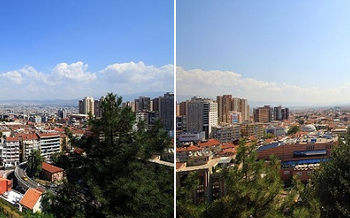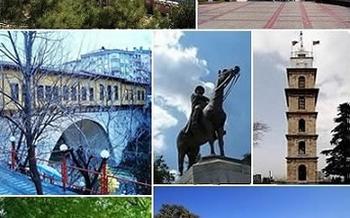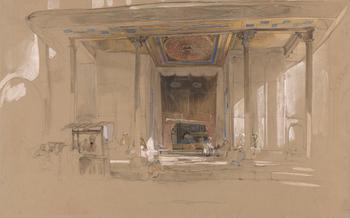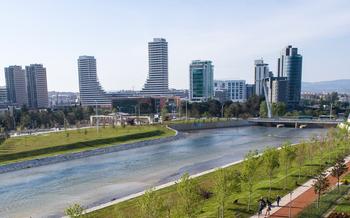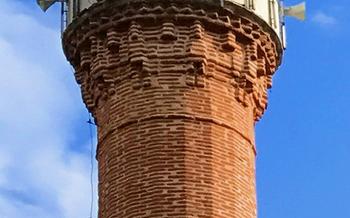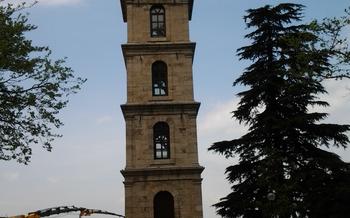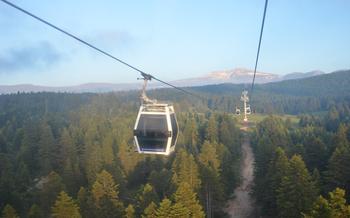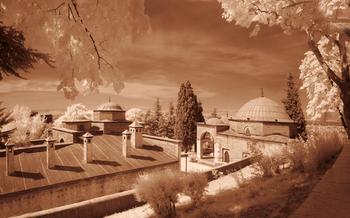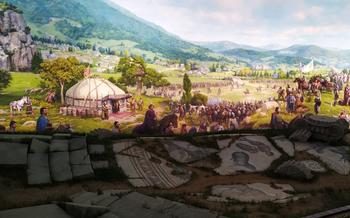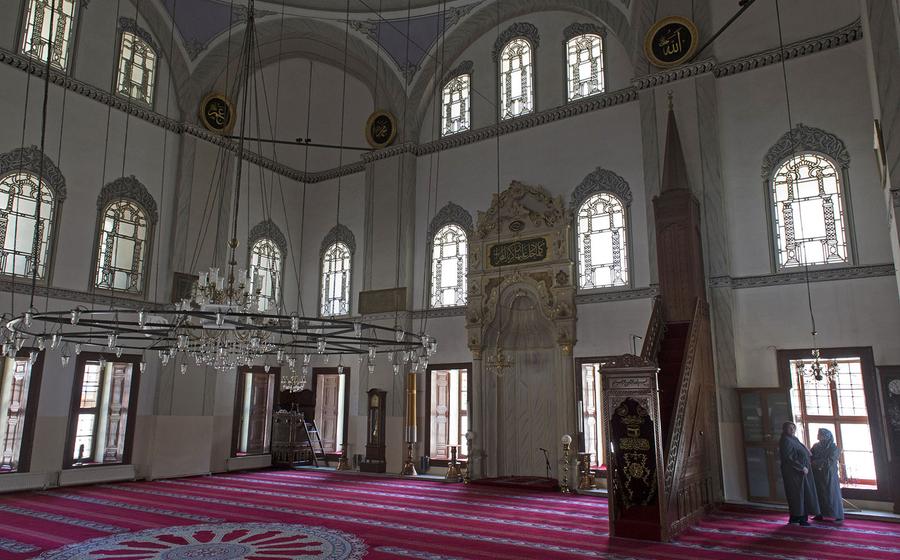
Emir Sultan Mosque
- The Emir Sultan Mosque: A Monument to Bursa’s Rich History
- Location and Accessibility: Finding the Mosque with Ease
- Unveiling the History: A Journey Through Time
- Immerse in the Architecture: A Masterpiece of Ottoman Design
- Interior Exploration: Discover the Hidden Treasures
- Sultan’s Final Resting Place: Paying Tribute
- Cultural Significance: A Symbol of Faith and Unity
- Dress Code and Etiquette: Respecting Local Customs
- Visiting Hours: Plan Your Pilgrimage Wisely
- Guided Tours: Unveiling Hidden Stories
- Photography and Videography: Capturing the Beauty
- Emir Sultan Complex: A Hidden Gem to Explore
- Nearby Attractions: Enrich Your Bursa Experience
- Local Delights: Savor Bursa’s Culinary Treasures
- Insider Tip: Discover Bursa’s Hidden Gems
The Emir Sultan Mosque: A Monument to Bursa’s Rich History
In the heart of Bursa, Turkey, stands the majestic Emir Sultan Mosque, a testament to the city’s rich history and cultural heritage. Built in the 15th century, the mosque has become a symbol of Bursa’s Islamic identity and a must-see destination for travelers. Its stunning architecture, intricate tilework, and serene atmosphere make it a masterpiece of Ottoman design and a sacred place for Muslims worldwide.
As you approach the mosque, its grandeur will immediately captivate you. The imposing dome, flanked by two slender minarets, dominates the skyline, while the intricate carvings and colorful tiles adorning the façade hint at the architectural treasures that await inside. The mosque holds immense historical significance, as it was built by Sultan Murad II in honor of Emir Sultan, a revered Sufi saint who played a crucial role in spreading Islam throughout the region.
The Emir Sultan Mosque is not just a religious site; it is also a cultural landmark that reflects the harmonious coexistence of different faiths in Bursa. Throughout history, the mosque has been a place of worship, learning, and community gatherings, fostering a sense of unity and understanding among people of diverse backgrounds.
Location and Accessibility: Finding the Mosque with Ease
The Emir Sultan Mosque is conveniently situated in the heart of Bursa, Turkey, at Emir Sultan Cad. No:10, Osmangazi. Its prime location makes it easily accessible by various means of transportation.
Public Transportation:
- Tram: Take the tram line to the Emir Sultan stop, which is just a short walk from the mosque.
- Bus: Several bus lines stop near the mosque, including the 1/A, 1/B, 1/C, 2/A, 2/B, 2/C, 3/A, 3/B, 3/C, and 4/A buses.
Parking:
- On-Street Parking: Limited on-street parking is available in the vicinity of the mosque.
- Parking Lots: There are several paid parking lots within walking distance of the mosque.
Nearby Landmarks:
- Ulu Cami (Grand Mosque): Bursa's iconic Grand Mosque is located just a short walk from the Emir Sultan Mosque.
- Bursa Castle: The historic Bursa Castle, with its impressive walls and towers, is situated on a hill overlooking the city, a few kilometers from the mosque.
- Koza Han (Silk Market): This bustling covered market, famous for its silk trade, is a must-visit for those interested in Bursa's textile heritage, located a few minutes walk from the mosque.
Unveiling the History: A Journey Through Time
The Emir Sultan Mosque's construction was commissioned by Sultan Bayezid I in 1391, as a tribute to the revered Sufi saint and scholar Emir Sultan, who had passed away in 138The construction was completed in 1399, during the reign of Sultan Bayezid's son, Sultan Mehmed I.
Over the centuries, the mosque has undergone several renovations and restorations. The most significant restoration took place in the 19th century, under the reign of Sultan Abdülmecid, when the mosque's interior was extensively renovated and embellished.
The Emir Sultan Mosque showcases a blend of architectural influences, reflecting the cultural and artistic diversity of Bursa during the Ottoman period. The mosque's design incorporates elements of Seljuk and Byzantine architecture, with a strong emphasis on symmetry and balance. The use of intricate tilework and calligraphy further enhances the mosque's aesthetic appeal.
Immerse in the Architecture: A Masterpiece of Ottoman Design
The Emir Sultan Mosque stands as a testament to the architectural prowess of the Ottoman Empire. Its unique features set it apart from other mosques in Turkey. The mosque's symmetry and balance are evident in its layout and design. The central dome, supported by four massive pillars, creates a sense of grandeur. The slender minarets flanking the entrance add to the mosque's visual appeal.
Intricate details adorn every corner of the mosque. From the finely carved stonework to the intricate tilework, each element contributes to the mosque's overall beauty. The mihrab, a niche indicating the direction of Mecca, is a masterpiece of Islamic art. Its intricate tilework and calligraphy create a stunning focal point within the prayer hall.
Calligraphy and tilework play a significant role in the mosque's decoration. Verses from the Quran and the names of Allah and the Prophet Muhammad are inscribed in elegant calligraphy on the walls and ceilings. The vibrant colors of the tiles, ranging from turquoise to deep blue, create a harmonious and visually stunning effect.
Interior Exploration: Discover the Hidden Treasures
Stepping inside the Emir Sultan Mosque, visitors are greeted by an awe-inspiring spectacle of intricate details and stunning craftsmanship. The prayer hall, the heart of the mosque, exudes an atmosphere of serenity and grandeur. Its vast space, adorned with intricate tilework and calligraphy, creates a sense of wonder and reverence.
The mihrab, a sacred niche indicating the direction of Mecca, is a masterpiece of Islamic art. Its intricate carvings and colorful tiles depict verses from the Quran, creating a mesmerizing focal point for prayers. The minbar, or pulpit, stands adjacent to the mihrab, its elegant design and delicate carvings adding to the overall splendor of the interior.
Sunlight, filtering through the stained glass windows, casts a warm glow upon the interior, illuminating the intricate patterns and vibrant colors. Each window tells a story, depicting scenes from Islamic history or verses from the Quran, adding to the spiritual and artistic significance of the mosque.
Finally, the walls of the mosque are adorned with exquisite calligraphy, showcasing verses from the Quran and sayings of the Prophet Muhammad. These inscriptions, executed with precision and beauty, serve as a reminder of the deep Islamic heritage and teachings that permeate every corner of the Emir Sultan Mosque.
Sultan’s Final Resting Place: Paying Tribute
Within the Emir Sultan Mosque complex lies the revered tomb of Emir Sultan, a figure deeply intertwined with Bursa’s spiritual and cultural heritage. The mausoleum, a testament to his lasting influence, stands as a serene and sacred space, attracting pilgrims and visitors alike.
The tomb, adorned with intricate tilework and calligraphy, exudes an aura of reverence. Here, visitors can pay their respects to Emir Sultan, whose teachings and legacy continue to inspire generations. The mausoleum serves as a poignant reminder of his profound impact on Bursa’s Islamic identity.
Beyond the tomb, the mosque complex encompasses a tranquil garden, where visitors can find solace and reflection amidst the serene surroundings. The presence of other tombs and structures within the complex further enhances its spiritual significance, creating a palpable atmosphere of devotion and tranquility.
Cultural Significance: A Symbol of Faith and Unity
The Emir Sultan Mosque stands as a testament to Bursa's rich Islamic heritage, serving as a symbol of tolerance and coexistence. It has been a significant pilgrimage site for Muslims throughout history, attracting devotees from near and far. The mosque also acts as a center for Islamic learning, hosting religious gatherings, lectures, and educational programs. Its enduring presence and profound impact on the community highlight the mosque's crucial role in shaping Bursa's cultural identity.
Dress Code and Etiquette: Respecting Local Customs
When visiting the Emir Sultan Mosque, as with any religious site, it is essential to respect local customs and dress appropriately. Modest attire is expected of both men and women, with shoulders and knees covered. Women are required to wear a headscarf as a sign of respect. Upon entering the mosque, visitors are expected to remove their shoes and maintain silence and reverence. This creates a peaceful and contemplative atmosphere conducive to prayer and reflection. Observing these simple guidelines ensures that visitors show respect for the mosque's sanctity and the local culture.
Visiting Hours: Plan Your Pilgrimage Wisely
The Emir Sultan Mosque welcomes visitors during regular hours, providing ample opportunities for exploration and reflection. These hours typically fall between 9:00 AM and 6:00 PM daily, accommodating a range of schedules. However, it is important to note that during specific prayer times, non-Muslims may be restricted from entering the main prayer hall out of respect for worshippers.
For those seeking a truly immersive experience, visiting the mosque during Ramadan or on religious holidays is highly recommended. During these special occasions, the mosque exudes a heightened sense of spirituality, with increased footfall and vibrant decorations. However, it is crucial to be mindful of the heightened sensitivity and adhere to local customs and etiquette.
To fully appreciate the mosque's tranquility and avoid crowds, consider planning your visit outside of peak hours, such as early in the morning or late in the afternoon. This will allow you to delve into the mosque's serene atmosphere, admire its intricate details, and connect with its spiritual essence without distractions.
Guided Tours: Unveiling Hidden Stories
Enhance your visit to the Emir Sultan Mosque by joining a guided tour. Knowledgeable guides provide insightful narratives about the mosque's history, architecture, and cultural significance. They unveil hidden stories and anecdotes, bringing the mosque's past to life. With a guide, you'll gain a deeper understanding of the mosque's intricate details, artistic elements, and the role it has played in Bursa's Islamic heritage. Guided tours can be customized to suit your interests, ensuring a personalized and enriching experience. Embrace the opportunity to learn from experts and discover the mosque's secrets, making your pilgrimage truly unforgettable.
Photography and Videography: Capturing the Beauty
The Emir Sultan Mosque is a photographer's paradise, with every corner offering a unique perspective and intricate detail. However, it's important to be mindful of the mosque's sacred nature and follow the guidelines for respectful photography. Flash photography and tripods are not allowed, as they can be disruptive to the worshippers and damage the delicate interior. Instead, use natural light to capture the mosque's beauty and ambiance.
When photographing the mosque, focus on capturing its symmetry and balance, as well as the intricate details of the tilework, calligraphy, and stained glass windows. Experiment with different angles and perspectives to create unique and captivating shots. Remember, the mosque is a living place of worship, so be respectful of the worshippers and avoid taking photos that may disturb them.
Once you've captured the beauty of the mosque's exterior and interior, don't forget to share your experiences with the world. Share your photos and videos on social media, tag the mosque, and use relevant hashtags to connect with other travelers and photography enthusiasts. By sharing your experiences, you can help promote the mosque and encourage others to visit this hidden gem in Bursa.
Emir Sultan Complex: A Hidden Gem to Explore
Beyond the mosque itself, the Emir Sultan Complex encompasses a treasure trove of additional structures and facilities that enhance the visitor experience. Historical tombs and serene gardens surround the mosque, inviting visitors to explore the resting places of important figures and immerse themselves in the tranquility of nature. A museum within the complex showcases a fascinating collection of Islamic artifacts, providing insights into the region's rich cultural heritage. For those seeking refreshments, cafes and shops are conveniently located nearby, offering a chance to savor local delicacies and souvenirs. Discover the hidden gems of the Emir Sultan Complex and delve deeper into the history and culture of Bursa.
Nearby Attractions: Enrich Your Bursa Experience
Bursa offers a wealth of captivating attractions beyond the Emir Sultan Mosque that will further enrich your exploration of this historic city.
-
Ulu Cami (Grand Mosque): A magnificent architectural marvel dating back to the 14th century, Ulu Cami boasts stunning tilework, intricate calligraphy, and a grand dome.
-
Bursa Castle and Panorama 1326 Museum: Perched atop a hill overlooking the city, Bursa Castle served as the capital of the Ottoman Empire in its early days. The Panorama 1326 Museum within the castle offers a captivating glimpse into the Battle of Bursa through a 360-degree panorama.
-
Koza Han (Silk Market): Step into the vibrant Koza Han, a bustling silk market that has been a hub of trade since the 15th century. Admire the intricate designs of traditional Turkish textiles and handicrafts.
-
Cumalıkızık Village: Escape the city's hustle and bustle in the charming village of Cumalıkızık, known for its well-preserved Ottoman-era houses, narrow cobblestone streets, and traditional crafts.
-
Mt. Uludağ for Nature and Winter Sports: For nature enthusiasts and adventure seekers, Mt. Uludağ beckons with its scenic hiking trails, lush forests, and thrilling winter sports opportunities.
Local Delights: Savor Bursa’s Culinary Treasures
Bursa is a city celebrated not only for its rich history and architectural wonders but also for its delectable cuisine. While visiting the Emir Sultan Mosque, take the opportunity to indulge in some of Bursa’s culinary treasures.
A must-try dish is the renowned Iskender kebap, a flavorful combination of thinly sliced döner meat, crispy pide bread, melted butter, and tangy tomato sauce. The aroma of grilled meat and the richness of the sauce create a harmonious symphony of flavors.
Bursa pide, a local variation of Turkish pide, is another delicacy not to be missed. These boat-shaped flatbreads are topped with various fillings, such as minced meat, cheese, or vegetables, and baked to perfection. The crispy exterior and the soft, chewy interior make for a satisfying culinary experience.
For a sweet treat, try the famous candied chestnuts, a specialty of Bursa. These sugary delights are a perfect blend of sweetness and crunch, making them a popular treat among locals and visitors alike.
Accompany your meal with a cup of traditional Turkish coffee, brewed using finely ground coffee beans and served in small, ornate cups. The strong aroma and rich flavor of Turkish coffee are sure to invigorate your senses.
Numerous eateries and cafes are located near the Emir Sultan Mosque, offering a range of culinary options to suit every palate. Take your time to savor the local flavors and immerse yourself in the vibrant food culture of Bursa.
Insider Tip: Discover Bursa’s Hidden Gems
Beyond the Emir Sultan Mosque, Bursa offers a wealth of hidden gems waiting to be explored. One such gem is the Cumalıkızık neighborhood. Nestled on the slopes of Mt. Uludağ, this charming village boasts well-preserved Ottoman architecture, cobblestone streets, and traditional crafts shops. Take a leisurely stroll through Cumalıkızık, admiring the historic houses, sampling local delicacies, and perhaps even picking up a unique souvenir.
For a breathtaking panoramic view of Bursa and the surrounding countryside, ascend Mt. Uludağ. This majestic mountain offers a variety of hiking trails, skiing slopes, and scenic viewpoints. Take a cable car to the summit and enjoy a memorable experience amidst nature.
To immerse yourself in the local culture, indulge in a traditional Turkish bath experience. Bursa is renowned for its historical baths, where you can relax and rejuvenate in the soothing steam and heat. Treat yourself to a massage and other spa treatments for a truly revitalizing experience.
